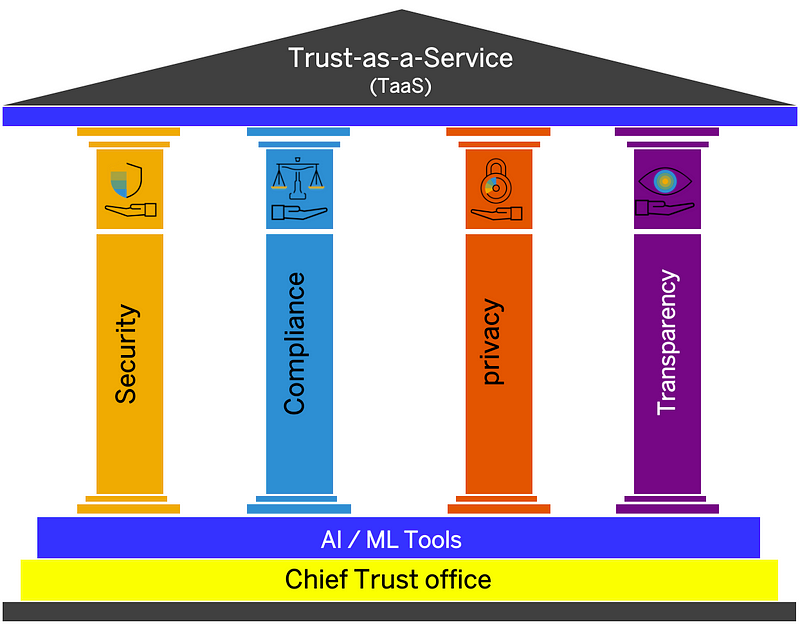Building Trust with Technology: The Role of AI in TaaS
Written on
Chapter 1: Understanding Trust-as-a-Service (TaaS)
Trust is a fundamental aspect of any business relationship. According to the Oxford dictionary, trust is defined as a "firm belief in the reliability, truth, ability, or strength of someone or something." In a business context, this means that customers are more likely to trust a company when they have proof that it is reliable, consistent, financially sound, transparent, and capable of safeguarding their data and information. Achieving excellence in these areas is challenging, and even more so is leveraging this information to build stronger connections.
Trust-as-a-Service (TaaS) is essential for nurturing these connections, as it lays the groundwork for long-term business success. The cybersecurity sector operates under the mantra of "never trust, always verify," which adds complexity for Trust Offices. Customers require solid evidence and third-party validations before they can place their trust in a business. The Chief Trust Office (CTrO) aims to address this by promoting trust through transparency.
As illustrated in the diagram below, TaaS is anchored on four critical pillars: Compliance, Security, Privacy, and Transparency. The objective of TaaS is to demonstrate to customers that a business meets industry standards and regulatory requirements, implements robust security measures, ensures data privacy, and maintains transparency.

Chapter 2: The Expanding Scope of TaaS
TaaS is not confined to the tech industry; it extends far beyond traditional security measures like VPNs and firewalls, gaining traction across various sectors. However, as public cloud adoption has surged in recent years, the issue of trust has become increasingly critical, especially in technology. After all, it’s not easy to rest easy knowing that your sensitive data is managed by a company located halfway across the globe.
Video Title: The S-Curve Of Trust Level 4 & 5: When Trust Goes Wrong by Dr. Mark Hollyoake, Customer Attuned - YouTube
Chapter 3: Leveraging AI and Automation to Enhance Trust
Building customer confidence across these four pillars of trust requires significant time and resources. Like many areas of business, Trust Offices face resource constraints, but advanced technologies such as Artificial Intelligence (AI) and Machine Learning (ML) can significantly aid in scaling trust.
Section 3.1: Privacy
Data privacy refers to a business's capacity to collect, use, and share customer data, particularly Personally Identifiable Information (PII) and other sensitive data. This area is governed by laws and regulations that dictate how customer information should be utilized. AI-powered privacy tools simplify this process by scanning data sources and even plain text documents to identify PII or other sensitive information. These tools can indicate which PII needs to be masked, removed, or retained.
Recent data breaches often stem from misconfigured data storage or unauthorized access. AI tools can effectively address these issues by verifying proper configurations and access to data storage.
Section 3.2: Security
Data security is designed to protect information from unauthorized access, safeguarding it from both internal and external threats. A layered security approach, known as defense-in-depth, is crucial for protecting customer data. AI plays a pivotal role in enhancing security through intelligent firewalls and sophisticated Security Information and Event Management (SIEM) systems. Additionally, AI assists in integrating security protocols into the development process and automating the DevSecOps pipeline. Machine Learning-based systems can create iterative models to enhance security measures continuously. AI technologies are also employed in Threat and Risk Analysis, helping to predict attacks and scrutinize logs for suspicious activities.
Section 3.3: Compliance
One of the most impactful applications of AI in fostering trust lies in compliance. Compliance involves third-party validations (often by auditors) that ensure businesses adhere to industry standards and government regulations. AI tools can automate compliance monitoring, significantly reducing the time and resources required for compliance checks. For instance, AI can enforce GDPR compliance by restricting data access to EU users only, eliminating the need for manual configurations prone to errors.
Section 3.4: Transparency
Transparency serves as the bedrock for building trust and is a fundamental responsibility of the Trust Office. By being transparent, a business can demonstrate its effectiveness in security, privacy, and compliance practices. AI technologies power various due diligence tools and dashboards that provide customers with crucial information regarding privacy, security, compliance, and overall business practices.
Chapter 4: The Role of the Chief Trust Office (CTrO)
The Chief Trust Office functions as a command center for TaaS. The CTrO collects relevant information on privacy, security, compliance, and transparency from various departments within the organization. This consolidated information is then made accessible to customers, partners, and vendors. Additionally, the CTrO is responsible for producing documentation—such as whitepapers, blogs, and videos—that detail privacy, security, and compliance processes.
The Bottom Line
TaaS represents a proactive approach to cultivating trust among customers, vendors, and partners. Technologies like AI facilitate this endeavor, making it simpler to foster trust. When businesses are transparent about their operations, especially regarding security and privacy, they build stronger relationships with customers and partners. This enhanced trust leads to increased customer satisfaction, ultimately contributing to a healthier bottom line!